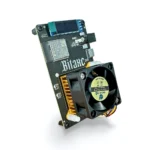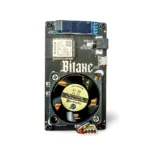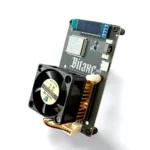Can Bitaxe Ultra be used for mining other cryptocurrencies besides Bitcoin?
Can Bitaxe Ultra Be Used for Mining Other Cryptocurrencies Besides Bitcoin?
The cryptocurrency mining landscape has evolved dramatically over the years, with specialized hardware like ASIC (Application-Specific Integrated Circuit) miners dominating the scene. Among these, the Bitaxe Ultra stands out as a revolutionary device designed specifically for Bitcoin mining. But as the crypto ecosystem diversifies, many miners are asking: *Can the Bitaxe Ultra be used for mining other cryptocurrencies besides Bitcoin?* This article delves into the technical capabilities, limitations, and practical applications of the Bitaxe Ultra to answer this question comprehensively.
Bitaxe Ultra: A Game-Changer in Bitcoin Mining
Before exploring its versatility, it’s essential to understand what makes the Bitaxe Ultra a standout product in the Bitcoin mining world. As the first open-source ASIC miner, the Bitaxe Ultra represents a significant leap forward in terms of transparency, efficiency, and accessibility.
Product Introduction
The Bitaxe Ultra is built around the BM1366 ASIC chip, delivering an impressive hashrate of 500 GH/s while consuming just 15 watts of power. Its energy efficiency (approximately 33.3 GH/s per watt) makes it one of the most sustainable mining devices in its class. The integration of the ESP32-S3-WROOM-1 microcontroller and 16MB of flash storage ensures reliable operation and firmware flexibility, while its compact design (10 x 6 cm) and lightweight build (73g) make it ideal for various deployment scenarios.

What truly sets the Bitaxe Ultra apart is its open-source architecture, which allows users to inspect, modify, and optimize the hardware and software. This transparency fosters trust and community-driven innovation, making it a favorite among tech-savvy miners.
Product Advantages
- Open-Source Transparency: Users can verify and modify the hardware and software, ensuring complete control over their mining operations.
- Exceptional Energy Efficiency: At just 15 watts, it reduces operational costs and environmental impact.
- Network Sovereignty: Miners can process their own block templates, contributing to Bitcoin’s decentralization and security.
- Compact and Flexible Design: Its small form factor and advanced cooling options make it adaptable to various environments.
The Core Question: Mining Beyond Bitcoin
The Bitaxe Ultra is explicitly designed for Bitcoin mining, leveraging its SHA-256 algorithm. However, the broader cryptocurrency ecosystem includes numerous coins that use different consensus algorithms, such as Scrypt (Litecoin), Ethash (Ethereum Classic), or Equihash (Zcash). To determine whether the Bitaxe Ultra can mine other cryptocurrencies, we must explore its technical specifications and the nature of ASIC mining.
Understanding ASIC Mining
ASIC miners are engineered to perform specific tasks with unparalleled efficiency. The Bitaxe Ultra’s BM1366 chip is optimized for the SHA-256 algorithm, which underpins Bitcoin and a handful of other cryptocurrencies like Bitcoin Cash and Bitcoin SV. This specialization means it excels at solving SHA-256-based problems but is inherently limited when it comes to other algorithms.
Cryptocurrencies Compatible with Bitaxe Ultra
Given its SHA-256 optimization, the Bitaxe Ultra can technically mine any cryptocurrency that uses this algorithm. Examples include:
- Bitcoin (BTC)
- Bitcoin Cash (BCH)
- Bitcoin SV (BSV)
- DigiByte (DGB) – Although DigiByte primarily uses Scrypt, it also supports SHA-256 mining.
For miners interested in these coins, the Bitaxe Ultra offers a viable and efficient solution. However, its application is restricted to SHA-256-based cryptocurrencies, limiting its versatility compared to GPU miners, which can handle multiple algorithms.

Challenges in Mining Non-SHA-256 Cryptocurrencies
While the Bitaxe Ultra’s efficiency and open-source nature make it an attractive option, its inability to mine non-SHA-256 cryptocurrencies is a significant limitation. Here’s why:
- Algorithmic Specialization: ASIC miners like the Bitaxe Ultra are hardwired for specific algorithms. Mining coins that use Scrypt, Ethash, or Equihash would require entirely different hardware.
- Economic Viability: Even if a workaround were found, the Bitaxe Ultra’s performance on non-SHA-256 algorithms would likely be suboptimal, making it economically unfeasible.
- Firmware Limitations: While the open-source nature allows for firmware modifications, these changes cannot override the fundamental hardware constraints of the BM1366 chip.
Practical Applications and Use Cases
Despite its limitations, the Bitaxe Ultra remains a powerful tool for miners focused on SHA-256-based cryptocurrencies. Here’s how it can be utilized effectively:
Solo Bitcoin Mining
The Bitaxe Ultra’s ability to process its own block templates makes it an excellent choice for solo miners who value network sovereignty and decentralization. While the odds of successfully mining a block are lower than in pooled mining, the potential rewards are significantly higher.
Small-Scale Operations
Its compact size and low power consumption make the Bitaxe Ultra ideal for small-scale mining setups. Whether deployed in a home office or a remote location, it offers professional-grade performance without the need for extensive infrastructure.
Educational and Experimental Use
As an open-source device, the Bitaxe Ultra is perfect for hobbyists and developers interested in exploring the technical intricacies of Bitcoin mining. Its transparency allows users to experiment with firmware modifications, contributing to the broader mining community.
Future Possibilities and Community-Driven Innovation
One of the most exciting aspects of the Bitaxe Ultra is its potential for future development. While it currently supports only SHA-256 mining, its open-source nature opens the door for community-driven innovations. Some possibilities include:
- Algorithmic Expansion: Future iterations or modifications could potentially support additional algorithms, though this would require significant hardware redesign.
- Firmware Enhancements: Community contributions could lead to improved efficiency, better thermal management, or enhanced user interfaces.
- Integration with Other Networks: Developers could explore ways to integrate the Bitaxe Ultra with emerging blockchain technologies, broadening its utility.
Conclusion: A Focused Tool with Limited Versatility
In summary, the Bitaxe Ultra is a groundbreaking ASIC miner designed specifically for SHA-256-based cryptocurrencies like Bitcoin, Bitcoin Cash, and Bitcoin SV. Its open-source architecture, exceptional energy efficiency, and compact design make it a valuable addition to any miner’s toolkit. However, its specialization means it cannot be used for mining non-SHA-256 cryptocurrencies like Litecoin, Ethereum Classic, or Zcash.
For miners focused on Bitcoin and related coins, the Bitaxe Ultra offers an efficient, transparent, and decentralized solution. Its real-world applications span solo mining, small-scale operations, and educational use, making it accessible to a wide range of users. While its versatility is limited by its algorithmic focus, its open-source nature ensures it remains a dynamic and evolving platform, driven by the ingenuity of its user community.

Whether you’re a seasoned miner or a crypto enthusiast looking to deepen your understanding of Bitcoin mining, the Bitaxe Ultra stands as a testament to the power of innovation and transparency in the ever-evolving world of cryptocurrency.